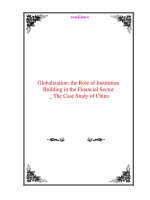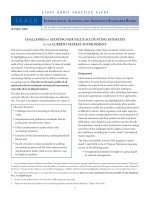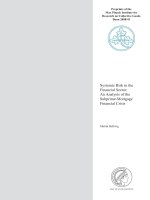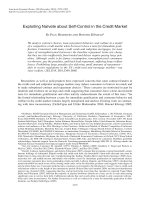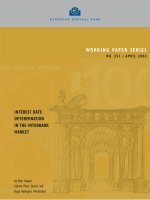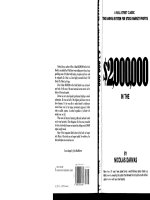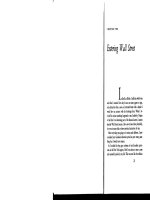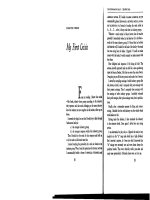knight & satchell (eds.) - forecasting volatility in the financial market, 3e (2007)
Bạn đang xem bản rút gọn của tài liệu. Xem và tải ngay bản đầy đủ của tài liệu tại đây (3.24 MB, 428 trang )
Forecasting Volatility in the Financial Markets
Quantitative Finance Series
Aims and Objectives
•
books based on the work of financial market practitioners, and academics
•
presenting cutting edge research to the professional/practitioner market
•
combining intellectual rigour and practical application
•
covering the interaction between mathematical theory and financial practice
•
to improve portfolio performance, risk management and trading book performance
•
covering quantitative techniques
Market
Brokers/Traders; Actuaries; Consultants; Asset Managers; Fund Managers; Regulators;
Central Bankers; Treasury Officials; Technical Analysts; and Academics for Masters in
Finance and MBA market.
Series Titles
Return Distributions in Finance
Derivative Instruments
Managing Downside Risk in Financial Markets
Economics for Financial Markets
Performance Measurement in Finance
Real R&D Options
Forecasting Volatility in the Financial Markets, Third Edition
Advanced Trading Rules, Second Edition
Advances in Portfolio Construction and Implementation
Computational Finance
Linear Factor Models in Finance
Initial Public Offerings
Funds of Hedge Funds
Venture Capital in Europe
Series Editor
Dr Stephen Satchell
Dr Satchell is the Reader in Financial Econometrics at Trinity College, Cambridge; Vis-
iting Professor at Birkbeck College, City University Business School and University of
Technology, Sydney. He also works in a consultative capacity to many firms, and edits the
journal Derivatives: use, trading and regulations and the Journal of Asset Management.
Forecasting Volatility in the
Financial Markets
Third edition
Edited by
John Knight
Stephen Satchell
AMSTERDAM
•
BOSTON
•
HEIDELBERG
•
LONDON
NEW YORK
•
OXFORD
•
PARIS
•
SAN DIEGO
SAN FRANCISCO
•
SINGAPORE
•
SYDNEY
•
TOKYO
Butterworth-Heinemann is an imprint of Elsevier
Butterworth-Heinemann is an imprint of Elsevier
Linacre House, Jordan Hill, Oxford OX2 8DP, UK
30 Corporate Drive, Suite 400, Burlington, MA 01803, USA
First edition 1998
Second edition 2002
Third edition 2007
Copyright © 2007 Elsevier Ltd. All rights reserved
No part of this publication may be reproduced, stored in a retrieval system
or transmitted in any form or by any means electronic, mechanical, photocopying,
recording or otherwise without the prior written permission of the publisher
Permissions may be sought directly from Elsevier’s Science & Technology Rights
Department in Oxford, UK: phone (+44) (0) 1865 843830; fax (+44) (0) 1865 853333;
email: Alternatively you can submit your request online by
visiting the Elsevier web site at and selecting
Obtaining permission to use Elsevier material
Notice
No responsibility is assumed by the publisher for any injury and/or damage to persons
or property as a matter of products liability, negligence or otherwise, or from any use
or operation of any methods, products, instructions or ideas contained in the material
herein.
British Library Cataloguing in Publication Data
A catalogue record for this book is available from the British Library
Library of Congress Cataloguing in Publication Data
A catalogue record for this book is available from the Library of Congress
ISBN–13: 978-0-7506-6942-9
ISBN–10: 0-7506-6942-X
For information on all Butterworth-Heinemann publications
visit our web site at
Printed and bound in The Netherlands
0708091011 10987654321
Working together to grow
libraries in developing countries
www.elsevier.com | www.bookaid.org | www.sabre.org
Contents
List of contributors vii
Preface to third edition ix
Introduction xi
1 Volatility modelling and forecasting in finance 1
Linlan Xiao and Abdurrahman Aydemir
2 What good is a volatility model? 47
Robert F. Engle and Andrew J. Patton
3 Applications of portfolio variety 65
Dan diBartolomeo
4 A comparison of the properties of realized variance for the FTSE 100
and FTSE 250 equity indices 73
Rob Cornish
5 An investigation of the relative performance of GARCH models versus
simple rules in forecasting volatility 101
Thomas A. Silvey
6 Stochastic volatility and option pricing 131
George J. Jiang
7 Modelling slippage: an application to the bund futures contract 173
Emmanuel Acar and Edouard Petitdidier
8 Real trading volume and price action in the foreign exchange markets 187
Pierre Lequeux
9 Implied risk-neutral probability density functions from option prices:
a central bank perspective 201
Bhupinder Bahra
10 Hashing GARCH: a reassessment of volatility forecasting performance 227
George A. Christodoulakis and Stephen E. Satchell
vi Contents
11 Implied volatility forecasting: a comparison of different procedures
including fractionally integrated models with applications to UK
equity options 249
Soosung Hwang and Stephen E. Satchell
12 GARCH predictions and the predictions of option prices 279
John Knight and Stephen E. Satchell
13 Volatility forecasting in a tick data model 295
L.C.G. Rogers
14 An econometric model of downside risk 301
Shaun Bond
15 Variations in the mean and volatility of stock returns around
turning points of the business cycle 333
Gabriel Perez-Quiros and Allan Timmermann
16 Long memory in stochastic volatility 351
Andrew C. Harvey
17 GARCH processes – some exact results, some difficulties
and a suggested remedy 365
John L. Knight and Stephen E. Satchell
18 Generating composite volatility forecasts with random factor betas 391
George A. Christodoulakis
Index 407
List of contributors
E. Acar
Bank of America, UK
A.B. Aydemir
Family and Labour Studies Division, Statistics Canada, Ottawa, Canada
B. Bahra
Bank of England, UK
S. Bond
University of Cambridge, Cambridge, UK
G.A. Christodoulakis
Faculty of Finance, Manchester Business School, UK
R. Cornish
Global Asset Management Ltd, London, UK
D. diBartolomeo
Northfield Information Services, Inc., Boston, USA
R.F. Engle
Stern School of Business, New York University, USA
A.C. Harvey
Faculty of Economics, University of Cambridge, UK
S. Hwang
Cass Business School, London, UK
G.J. Jiang
Finance Department, Eller College of Business and Public Administration, University of
Arizona, USA
J.L. Knight
Department of Economics, University of Western Ontario, Canada
P. Lequeux
Banque Nationale de Paris plc, London, UK
Linlan Xiao
Department of Economics, University of Western Ontario, Canada
A.J. Patton
Financial Markets Group, London School of Economics, UK
viii List of contributors
G. Perez-Quiros
Federal Reserve Bank of New York, USA
E. Petitdidier
Systeia Capital Management, Paris, France
L.C.G. Rogers
Department of Mathematics, University of Cambridge, UK
S.E. Satchell
Faculty of Economics, Trinity College and University of Cambridge, UK
T.A. Silvey
Trinity College, Cambridge, UK
A. Timmermann
Department of Economics, University of California, San Diego, USA
Preface to third edition
The third edition of this book includes the earlier work in the first two editions plus five
new chapters. One of these five chapters is a contribution by Professor Rob Engle; we are
honoured to include his work. This chapter is written jointly with Andrew Patton. We also
have a research piece by one of the world’s leading risk practitioners, Dan diBartolomeo,
Principal of Northfield and a valued contributor to many international conferences. The
remaining new chapters are by three young promising researchers, Rob Cornish, Linlan
Xiao and Tom Silvey.
We hope readers enjoy the new edition. Both editors were pleased by the popularity of
the first two editions and valued the feedback received.
This page intentionally left blank
Introduction
This book presents recent research on volatility in financial markets with a special empha-
sis on forecasting. This literature has grown at a frightening rate in recent years, and
would-be readers may feel daunted by the prospect of learning hundreds of new acronyms
prior to grappling with the ideas they represent. To reduce the entry costs of our readers,
we present two summary chapters; a chapter on volatility in finance by Linlan Xiao
and A.B. Aydemir, and a survey of applications of stochastic volatility models to option
pricing problems by G.J. Jiang. This is an area of some importance, as one of the sources
of data in the study of volatility is the implied volatility series derived from option prices.
As mentioned previously, we are delighted to reproduce a paper by Professor Engle
written jointly with A. Patton. We include a number of practitioner chapters, namely one
by D. diBartolomeo, one by R. Cornish, one by E. Acar and E. Petitdidier, and one by
P. Lequeux. We have a chapter by a monetary economist, B. Bahra. All these chapters focus
on practical issues concerning the use of volatilities; some examine high-frequency data,
others consider how risk-neutral probability measurement can be put into a forecasting
framework.
We have a number of chapters concentrating on direct forecasting using GARCH,
forecasting implied volatility and looking at tick-by-tick data. These chapters concentrate
much more on theoretical issues in volatility and risk modelling. S. Bond considers
dynamic models of semi-variance, a measure of downside risk. G. Perez-Quiros and
A. Timmermann examine connections between volatility of stock markets and business
cycle turning points. A. Harvey examines long memory stochastic volatility, while
J. Knight and S. Satchell consider some exact properties of conditional heteroscedasticity
models. T. Silvey answers a question, very vexing to theorists, as to why simple moving
average rules for forecasting volatility can outperform sophisticated models.
Taken together, these chapters reflect the extraordinary diversity of procedures now
available for forecasting volatility. It seems likely that many of these can be incorporated
into trading strategies or built into investment technology products. The editors have put
the book together with the twin goals of encouraging both researchers and practitioners,
and we hope that this book is useful to both audiences.
This page intentionally left blank
1 Volatility modelling and forecasting
in finance
Linlan Xiao
∗
and Abdurrahman Aydemir
†
1.1 Introduction
Volatility modelling and forecasting have attracted much attention in recent years, largely
motivated by its importance in financial markets. Many asset-pricing models use volatility
estimates as a simple risk measure, and volatility appears in option pricing formulas
derived from such models as the famous Black–Scholes model and its various extensions.
For hedging against risk and for portfolio management, reliable volatility estimates and
forecasts are crucial.
In an effort to account for different stylized facts, several types of models have been
developed. We have the Autoregressive Moving Average (ARMA) models, Autoregressive
Conditional Heteroscedasticity (ARCH) models, Stochastic Volatility (SV) models, regime
switching models and threshold models.
ARCH-type models have been reviewed by, amongst others, Bollerslev, Chou and Kroner
(1992), Bollerslev, Engle and Nelson (1994), Bera and Higgins (1995) and Diebold and
Lopez (1995). Ghysels, Harvey andRenault (1996) providea very nice survey of SV models.
An excellent review of volatility forecasting can be found in Poon and Granger (2003).
While the abovementioned review papers mainly focus on a single class of models, this
study presents all available techniques for modelling volatility and tries to highlight the
similarities and differences between them. The emphasis in this chapter is on applications
in finance. Due to the space limitations we do not cover the specifics of several issues,
such as estimation and testing in ARCH-type and SV models, as these are covered in
detail in previous studies. However, for the regime switching and threshold models we
deviate from this, since these models are relatively new in the literature and surveys are
not readily available.
Poon and Granger (2003) review the methodologies and empirical findings in more
than 90 published and working papers that study forecasting performance of various
volatility models. They also provide recommendations for forecasting in practice, and
ideas for further research. In this chapter we will briefly review their findings.
The next section starts with ARMA-type models and discusses their limitations for
modelling volatility. Section 1.3 highlights the stylized facts of volatility in financial data,
while section 1.4 presents ARCH-type models. SV models are discussed in section 1.5.
Section 1.6 considers models that allow for structural breaks in the underlying process, the
regime switching models, and section 1.7 concerns threshold models. Volatility forecasting
is discussed in section 1.8. The last section concludes.
∗
Department of Economics, Univeristy of Western Ontario, Canada
†
Family and Labour Studies Division, Statistics Canada, Ottawa, Canada
2 Forecasting Volatility in the Financial Markets
1.2 Autoregressive moving average models
For the past 50 years, linear Gaussian models have been the most commonly used models
for time-series analysis. The general representation for these models is:
X
t
=
0
+
p
j=1
j
X
t−j
+
q
j=0
j
t−j
(1.1)
where
j
and
j
are real constants,
p
= 0
q
= 0 and
t
are zero-mean uncorrelated
random variables, called white noise (WN),
1
with a common variance,
2
< . This is
an autoregressive moving average model or an ARMA(p,q) model. An ARMA(0,q) model
is referred to as the moving average model of order q, and denoted by MA(q); whereas
an ARMA(p,0) model is an autoregressive model of order p, denoted by AR(p).
Several advantages and limitations of these models are discussed in the literature (Tong,
1990). There are three main advantages. First, there is a complete theory available for
linear difference equations and, since the theory of Gaussian models is well understood,
there is also a well-developed theory of statistical inference (assuming normality for
t
).
Second, in terms of computation, modelling data with ARMA structure is easy, and there
are several statistical packages available for this purpose. Third, this class of models has
enjoyed a reasonable level of success in data analysis, forecasting and control.
ARMA-type models are widely used in the finance literature. A stationary AR(1) process
is used for modelling volatility of monthly returns on the Standard & Poor’s (S&P)
composite index by Poterba and Summers (1986). The logarithm of the volatility of S&P
monthly returns is modelled by a non-stationary ARIMA(0,1,3) by French, Schwert and
Stambaugh (1987), and is reported to work reasonably well. Schwert (1990) and Schwert
and Seguin (1990) use an AR(12) model for monthly volatility. ARMA-type models work
well as first-order approximations to many processes.
In many time-series data we observe asymmetries, sudden bursts at irregular time
intervals, and periods of high and low volatility. Exchange rate data provide an example
of this kind of behaviour. Also, cyclicality and time irreversibility is reported by several
practitioners using different data sets. Linear Gaussian models have definite limitations
in mimicking these properties.
One of the important shortcomings of the ARMA-type models is the assumption of
constant variance. Most financial data exhibit changes in volatility, and this feature of
the data cannot by captured under this assumption.
Tong (1990) criticizes linear Gaussian models, noting that if
t
is set equal to a constant
for all t, equation (1.1) becomes a deterministic linear difference equation in X
t
. X
t
will
have a ‘stable limit point’, as X
t
always tends to a unique finite constant, independent
of the initial value. The symmetric joint distribution of the stationary Gaussian ARMA
models does not fit data with strong asymmetry. Due to the assumption of normality, it
is more suitable to use these models with data that have only a negligible probability of
sudden bursts of very large amplitude at irregular time epochs.
For data exhibiting strong cyclicality, the autocorrelation function is also strongly
cyclical. Since the joint normality assumption implies the regression function at lag
j EX
t
X
t−j
j ∈Z, to be linear for ARMA models, at those lags for which the autocor-
relation function is quite small in modulus a linear approximation may not be appropriate.
Finally, ARMA models are not appropriate for data exhibiting time irreversibility.
Volatility modelling and forecasting in finance 3
These limitations of ARMA models lead us to models where we can retain the gen-
eral ARMA framework, allow the WN to be non-Gaussian, or abandon the linearity
assumption.
1.3 Changes in volatility
The main topic of interest of this chapter is the changing volatility found in many time
series. ARMA models assume a constant variance for
t
, and thus cannot account for
the observed changes in volatility, especially in financial data such as exchange rates and
stock returns. Before presenting different methods of volatility modelling, stylized facts
about volatility are presented in the next section.
1.3.1 Volatility in financial time series: stylized facts
Financial time series exhibit certain patterns which are crucial for correct model specifi-
cation, estimation and forecasting:
•
Fat tails. The distribution of financial time series, e.g. stock returns, exhibit fatter tails
than those of a normal distribution – i.e. they exhibit excess kurtosis. The standardized
fourth moment for a normal distribution is 3, whereas for many financial time series
it is well above 3 (Fama (1963, 1965) and Mandelbrot (1963) are the first studies to
report this feature). For modelling excess kurtosis, distributions that have fatter tails
than normal, such as the Pareto and Levy, have been proposed in the literature.
•
Volatility clustering. The second stylized fact is the clustering of periods of volatility,
i.e. large movements followed by further large movements. This is an indication of
shock persistence. Correlograms and corresponding Box–Ljung statistics show signif-
icant correlations which exist at extended lag lengths.
•
Leverage effects. Price movements are negatively correlated with volatility. This was
first suggested by Black (1976) for stock returns. Black argued, however, that the
measured effect of stock price changes on volatility was too large to be explained solely
by leverage effects. Empirical evidence on leverage effects can be found in Nelson
(1991), Gallant, Rossi and Tauchen (1992, 1993), Campbell and Kyle (1993) and
Engle and Ng (1993).
•
Long memory. Especially in high-frequency data, volatility is highly persistent, and
there is evidence of near unit root behaviour in the conditional variance process. This
observation led to two propositions for modelling persistence: the unit root or the
long memory process. The autoregressive conditional heteroscedasticity (ARCH) and
stochastic volatility (SV) models use the latter idea for modelling persistence.
•
Co-movements in volatility. When we look at financial time series across different
markets, e.g. exchange rate returns for different currencies, we observe big movements
in one currency being matched by big movements in another. This suggests the impor-
tance of multivariate models in modelling cross-correlations in different markets.
These observations about volatility led many researchers to focus on the cause of these
stylized facts. Information arrival is prominent in the literature, where many studies link
asset returns to information flow. Asset returns are observed and measured at fixed time
4 Forecasting Volatility in the Financial Markets
intervals: daily, weekly or monthly. Much more frequent observations, such as tick-by-tick
data, are also available. The rate of information arrival is non-uniform and not directly
observable. Mandelbrot and Taylor (1967) use the idea of time deformation to explain
fat tails. The same idea is used by Clark (1973) to explain volatility. Easley and O’Hara
(1992) try to link market volatility with the trading volume, quote arrivals, forecastable
events such as dividend announcements, and market closures.
To get reliable forecasts of future volatilities it is crucial to account for the stylized
facts. In the following sections, we discuss various approaches for volatility modelling
that try to capture these stylized facts.
1.3.2 The basic set-up
The basic set-up for modelling the changes in variance is to regard innovations in the
mean as being a sequence of independent and identically distributed random variables,
z
t
, with zero mean and unit variance, multiplied by a factor
t
, the standard deviation –
that is,
t
=
t
z
t
z
t
∼iid0 1 (1.2)
For modelling of
t
the first alternative is the stochastic volatility model, where
t
is
modelled by a stochastic process, such as an autoregression. Alternatively, variance is
modelled in terms of past observations using autoregressive conditional heteroscedasticity
(ARCH) models. In either case, the observations in (1.2) form a martingale difference
2
(MD) sequence, although they are not independent.
In many applications,
t
corresponds to the innovation in the mean for some other
stochastic process denoted by y
t
where
y
t
=fx
t−1
b+
t
(1.3)
with fx
t−1
ba function of x
t−1
which is in the t −1 information set, and b corresponding
to the parameter vector.
1.4 ARCH models
An important property of ARCH models is their ability to capture volatility clustering in
financial data, i.e. the tendency for large (small) swings in returns to be followed by large
(small) swings of random direction.
Within the ARCH framework,
t
is a time-varying, positive and measurable function
of the time t −1 information set. Engle (1982) proposed that the variance in (1.2) be
modelled in terms of past observations. The simplest possibility is to let:
2
t
= +
2
t−1
>0≥ 0 (1.4)
We need the constraints in (1.4) to ensure that variance remains positive. If z
t
is Gaussian,
so that (1.2) becomes
t
=
t
z
t
z
t
∼NID0 1 (1.5)
Volatility modelling and forecasting in finance 5
the model itself is conditionally Gaussian (NID above denotes normally and independently
distributed). We could write
t
t−1
∼ N0
2
t
t−1
is the set of observations up to time
t−1, and the model’s density is that of a one-step-ahead forecast density (Shephard, 1996).
The above specification allows today’s variance to depend on the variability of recent
observations. Conditional normality of
t
means
t
is an MD, and so its unconditional
mean is zero and is serially uncorrelated. Under strict stationarity
3
it has a symmetric
unconditional density. The conditional variance of
t
equals
2
t
, which may be changing
through time.
If 3
2
< 1, the kurtosis is greater than 3 for positive, so the ARCH model yields
observations with heavier tails than those of a normal distribution. If <1
t
is WN
while
2
t
follows an autoregressive process, yielding volatility clustering. This does not
imply covariance stationarity, since the variance of
2
t
will be finite only if 3
2
< 1
(Shephard, 1996).
Shephard (1996) discussed the advantages of building models out of explicit one-step-
ahead forecast densities. First, a combination of these densities delivers the likelihood via
prediction decomposition, which makes estimation and testing straightforward. Second,
finance theory is often specified using one-step-ahead moments. Third, this specification
parallels the successful AR and MA models which found wide applications for modelling
changes in means. Therefore, techniques developed for AR and MA models are applicable
to ARCH models.
1.4.1 Generalized ARCH
In the above representation of the ARCH model, conditional variance depends on a single
observation. It is desirable to spread the memory of the process over a number of past
observations by including more lags, thus allowing changes in variance to occur more
slowly. This leads to the following identification:
2
t
= +
1
2
t−1
+···+
p
2
t−p
(1.6)
This is denoted by ARCH(p), where >0 and
i
≥ 0. An ad hoc linearly declining
lag structure is often imposed to ensure a monotonic declining effect from more distant
shocks, such as
i
=q +1−i/qq +1 (see Engle, 1982, 1983). Including the lagged
values of
2
t
, we obtain the so-called generalized ARCH model:
2
t
= +
1
2
t−1
+···+
p
2
t−p
+
1
2
t−1
+···+
q
2
t−q
(1.7)
This model was first suggested by Bollerslev (1986) and Taylor (1986), and is termed
GARCH(p,q). All GARCH models are MDs. If the sum of the
i
’s and
i
’s is less than
one, the model is stationary and so is WN (Harvey, 1981, pp. 276–279). In most of the
empirical implementations, the values p ≤2q≤2 are sufficient to model the volatility,
providing a sufficient trade-off between flexibility and parsimony.
ARCH effects are documented in the finance literature by Akgiray (1989) for index
returns, Schwert (1990) for futures markets, and Engle and Mustafa (1992) for individual
stock returns. Using semiparametric methods Gallant and Tauchen (1989) explore the
daily NYSE value-weighted index for two periods, 1959–1978 and 1954–1984, and find
6 Forecasting Volatility in the Financial Markets
significant evidence of ARCH-type conditional heteroscedasticity and conditional non-
normality. Hsieh (1988) finds ARCH effects in five different nominal US dollar rates where
the conditional distributions of the daily nominal returns are changing through time.
However, an interesting observation reported by Diebold (1988), Baillie and Bollerslev
(1989) and Drost and Nijman (1993) is that ARCH effects which are highly significant
with daily and weekly data weaken as the frequency of data decreases. Diebold and
Nerlove (1989) and Gallant, Hsieh and Tauchen (1991) try to explain the existence of
ARCH effects in the high-frequency data by the amount of information, or the quality of
the information reaching the markets in clusters, or the time between information arrival
and the processing of the information by market participants. Engle, Ito and Lin (1990a)
also suggest information processing as the source of volatility clustering.
Nelson (1990) shows that the discrete time GARCH(1,1) model converges to a con-
tinuous time diffusion model as the sampling interval gets arbitrarily small. Even when
misspecified, appropriately defined sequences of ARCH models may still serve as con-
sistent estimators for the volatility of the true underlying diffusion, in the sense that the
difference between the true instantaneous volatility and the ARCH estimates converges
to zero in probability as the length of the sampling frequency diminishes. This impor-
tant result bridges the gap between finance theory which uses continuous time stochastic
differential equations and the discrete nature of all the financial time series available.
A related result is given by Nelson (1992), who shows that if the true model is a diffusion
model with no jumps, then the discrete time variances are consistently estimated by a
weighted average of past residuals as in the GARCH(1,1) formulation. Finally, Brock,
Hsieh and LeBaron (1991) show that if
2
t
is linear in the sense of Priestley (1980),
the GARCH(p,q) representation may be seen as a parsimonious approximation to the
possibly infinite Wold representation for
2
t
.
In modelling the above functional forms, normal conditional densities are generally
used. However, the normality assumption cannot adequately account for the observed
fat tails in the unconditional price and return distributions (Fama, 1965). McCurdy and
Morgan (1987), Milhoj (1987a), Baillie and Bollerslev (1989) and Hsieh (1989) give
evidence of uncaptured excess kurtosis in daily or weekly exchange rate data under
the assumption of conditional normality. This leads to departures from the normality
assumption. Weiss (1984, 1986) derives asymptotic standard errors for parameters in
the conditional mean and variance functions under non-normality. The use of parametric
densities other than normal include Student-t distribution (Bollerslev, 1987; Hsieh, 1989),
normal-Poisson mixture distribution (Jorion, 1988) and the normal-lognormal mixture
distribution (Hsieh, 1989), the power exponential distribution (Nelson, 1990). Baillie and
DeGennaro (1990) show that failure to model the fat-tailed property can lead to spurious
results in terms of the estimated risk-return trade-off where they assume that errors are
conditionally t-distributed.
There are also semiparametric approaches which provide more efficient estimates for
markedly skewed distributions; see Gallant, Hsieh and Tauchen (1991) and Gallant,
Rossi and Tauchen (1992). Engle and Gonzalez-Rivera (1991) explore stock returns for
small firms using a non-parametric method and draw attention to the importance of both
skewness and kurtosis in conditional density function of returns.
Before proceeding with other types of ARCH specifications, a few points about GARCH
models are worth noting.
Volatility modelling and forecasting in finance 7
The most crucial property of the GARCH models is linearity. GARCH models of the
type introduced by Engle (1982) and Bollerslev (1986) imply an ARMA equation for
the squared innovation process
2
. This allows for a complete study of the distributional
properties of (
t
) and also makes the statistical inference (parameter estimation, test for
homoscedasticity) easier.
As a result of the quadratic form choice for the conditional variance, the time paths
are characterized by periods of high and low volatility. The impact of past values of
innovations on current volatility is only a function of their magnitude. However, this is
not generally true in financial data. Several authors, such as Christie (1982), Campbell
and Hentschel (1992) and Nelson (1990, 1991) point out the asymmetry, where volatility
tends to be higher after a decrease than after an equal increase. The choice of quadratic
form for the conditional variance is a symmetric one and prevents modelling of such
phenomena.
The non-negativity constraint on the coefficients in GARCH models is only a suf-
ficient condition and may be weakened in certain cases (Nelson and Cao, 1992). As
noted by Rabemananjara and Zakoain (1993), non-negativity constraints may be a
source of important difficulties in running the estimation procedures. With the non-
negativity constraint, a shock in the past, regardless of the sign, always has a pos-
itive effect on the current volatility: the impact increases with the magnitude of the
shock. Therefore, cyclical or any non-linear behaviour in volatility cannot be taken into
account.
In empirical work it seems difficult to consider a large number of lags p and q. Several
authors have found it necessary to impose an ad hoc structure on the coefficients in these
models (Bollersev, 1986; Engle and Granger, 1987).
1.4.2 Integrated ARCH
If + =1 in the GARCH(1,1) model, we lose weak stationarity since it does not have
finite variance. Using squared observations and specification of variance leads to the
expression:
2
t
= +
2
t−1
+v
t
+v
t−1
(1.8)
where =− =1 − and v
t
=
2
t
z
2
t
−1. Rearranging (1.8):
2
t
= +v
t
+v
t−1
(1.9)
This leads to an analogy with ARIMA(0,1,1) in terms of defining an autocorrelation func-
tion (ACF) of squared observations. This model is called integrated GARCH (IGARCH),
since the squared observations are stationary in first differences, but it does not follow
that
2
t
will behave like an integrated process. IGARCH is still an MD process. We require
>0, otherwise, independent of the starting point,
2
t
almost certainly drops to zero –
that is, the series disappears.
In the IGARCH model, current information remains important for forecasts of the con-
ditional variance for all horizons. This property can account for the observed persistence
implied by the estimates of the conditional variance in the high-frequency financial data.
Using different sets of stock market data, several authors fail to reject the null hypothesis
8 Forecasting Volatility in the Financial Markets
of a unit root in variance (French, Schwert and Stambaugh, 1987; Chou, 1988; Pagan and
Schwert, 1990). Volatility persistence in interest rates also has been documented by many
studies using data on bond yields, returns on Treasury Bills, etc. (see Weiss, 1984; Hong,
1988). On the other hand, Engle and Bollerslev (1986), Bollerslev (1987) and McCurdy
and Morgan (1987, 1988), among other studies, report persistence of volatility shocks in
the foreign exchange market.
Although it is possible to observe persistence of variance in the univariate time-series
representations of different series, certain linear combinations of variables may show
no persistence. These variables are called co-persistent in variance (Bollerslev and Engle,
1993). In many asset-pricing relationships, this is crucial for the construction of optimal
long-term forecasts for the conditional variances and covariances. Schwert and Seguin
(1990) investigate the disaggregated stock portfolios, where they find evidence for a
common source of time-varying volatility across stocks, suggesting the portfolios might
be co-persistent. Bollerslev and Engle (1993) also present evidence on the presence of
co-persistence among the variances across exchange rates. Co-persistence is modelled by
multivariate ARCH formulations; this will be discussed later.
1.4.3 Exponential ARCH
Harvey (1981) reports a number of drawbacks with GARCH models. First, the conditional
variance is unable to respond asymmetrically to rises and falls in
t
, effects believed to
be important in the behaviour of stock returns. In the linear GARCH(p,q) model the
conditional variance is a function of past conditional variances and squared innovations,
so the sign of the returns cannot affect volatility. Therefore, GARCH models cannot
account for the leverage effects observed in stock returns. Second, estimated coefficients
often violate parameter constraints. Moreover, these constraints may excessively restrict
the dynamics of the conditional variance process. Third, it is difficult to assess whether
shocks to conditional variance are ‘persistent’ because of the somewhat paradoxical
behaviour noted earlier for IGARCH.
Nelson (1991) introduced EGARCH models, where conditional variance is con-
strained to be non-negative by assuming the logarithm of
2
t
is a function of the
past z
t
’s:
log
2
t
= +
i=1
i
gz
t−i
i
=1 (1.10)
gz
t
=wz
t
+
z
t
−E
z
t
(1.11)
where w and are real numbers. This specification enables
2
t
to respond asymmetrically
to rises and falls in
t
, since for z
t
>0 and z
t
<0 gz
t
will have different slopes (w + and
w − , respectively). The asymmetry of information is potentially useful, since it allows
the variance to respond more rapidly to falls in a market than to corresponding rises. This
is a stylized fact for many assets reported by Black (1976), Schwert (1989a), Campbell and
Hentschel (1992) and Sentana (1995). Nelson (1989, 1990) provides empirical support
for the EGARCH specification.
4
Volatility modelling and forecasting in finance 9
1.4.4 ARCH-M model
The trade-off between the risk and the expected return inherent in many finance theories
can be modelled by the ARCH-in-Mean model introduced by Engle, Lilien and Robins
(1987):
y
t
=fx
t−1
2
t
b+
t
A specific case of the above general expression is:
y
t
=f
2
t
b+
t
t
2
t
=
0
+
1
y
t−1
−f
2
t−1
b
2
A linear parameterization is commonly used in the literature:
f
2
t
b=
0
+
1
2
t
Hong (1991) discusses the statistical properties of the above specification.
The ARCH-M model was used in asset-pricing theories of CAPM, consumption-based
CAPM and the asset-pricing theory of Ross (1976). Depending on the functional form,
the conditional mean increases or decreases, with an increase in the conditional variance.
Mostly linear and logarithmic functions of
2
t
or
t
are used in the functional form. In
the linear specifications, the parameter measuring the effect of conditional variance on
excess return is interpreted as the coefficient of relative risk aversion.
In the linear specification, a constant effect of conditional variance on the expected
return is hypothesized. Harvey (1989), however, reports the coefficient to be varying over
time, depending on the phase of the business cycle. There is further empirical evidence
against the time-invariant relationship in Chou, Engle and Kane (1992).
Engle, Lilien and Robins (1987) use the ARCH-M model with interest-rate data where
the conditional variance proxies for the time-varying risk premium, and find that this
leads to a good fit to the data. Correct model specification is required for consistent
parameter estimation, as in the EGARCH model. Chou (1988), Attanasio and Wadhwani
(1989) and Campbell and Shiller (1989), among others, apply the ARCH-M model to
different stock index returns. The ARCH-M model is also used in exchange rate data.
The conditional distribution of spot exchange rates varies over time, leading to a time-
varying premium. To proxy for the risk premium, different functional forms that depend
on the conditional variance of the spot rate are employed in the empirical literature. Some
studies support a mean-variance trade-off (e.g. Kendall and McDonald, 1989), whereas
some reach the opposite conclusion (Kendall, 1989). Baillie and DeGennaro (1990) make
a sensitivity analysis of the parameter estimates for the ARCH-M model for different
model specifications under parametric specifications; Gallant, Rossi and Tauchen (1992)
do a similar exercise under semi-parametric specifications.
The use of the ARCH-M model for measuring risk has been criticized: Backus, Gregory
and Zin (1989) and Backus and Gregory (1993) challenge ARCH-M modelling theo-
retically, and Backus and Gregory (1993) show that there need not be any relationship
between the risk premium and conditional variances in their theoretical economy. Despite
the above criticisms, ARCH-M models are applied to many types of financial data.
10 Forecasting Volatility in the Financial Markets
1.4.5 Fractionally integrated ARCH
Ding, Granger and Engle (1993) discuss how volatility tends to change quite slowly, with
the effect of shocks taking a considerable time to decay. The formulation based on this
idea is the fractionally integrated ARCH (FIARCH) model, represented in its simplest
form by:
2
t
=
0
+1−1 −L
d
2
t
=
0
+L
2
t−1
where L is a polynomial in L that decays hyperbolically in lag length, rather than
geometrically. Baillie, Bollerslev and Mikkelsen (1996) introduce generalizations of this
model, which are straightforward transformations of the fractionally integrated ARMA
(ARFIMA) models of Granger and Joyeux (1980) and Hosking (1981) into long memory
models of variance.
1.4.6 Other univariate ARCH formulations
Other parametric models suggested in the literature include the Augmented ARCH model
of Bera, Lee and Higgins (1990), the Asymmetric ARCH model of Engle (1990), the
modified ARCH model of Friedman and Laibson (1989), the Qualitative ARCH model of
Gourieroux and Monfort (1992), the Structural ARCH model of Harvey, Ruiz and Sen-
tana (1992) and the Threshold ARCH model of Zakoian (1994),
5
the Absolute Residuals
ARCH model of Taylor (1986) and Schwert (1989b), the Non-linear ARCH (NARCH)
model of Engle and Bollerslev (1986) and Higgins and Bera (1992), and the Quadratic
ARCH (QARCH) model of Sentana (1995).
In the Structural ARCH model, ARCH disturbances appear in both the state and
updating equations.
The Absolute Residual model suggests
t
=
0
+
1
t−1
whereas the NARCH model is similar to Box-Cox generalization:
2
t
=
0
+
1
t−1
or a non-symmetric version:
2
t
=
0
+
1
t−1
−k
The Quadratic ARCH model captures asymmetry and has the form:
2
t
=
0
+
1
2
t−1
+
2
t−1
with the appropriate constraints on the parameters to ensure positivity of
t
2
.
There are also non-parametric alternatives suggested in the literature. One line of
research uses Kernel methods, where
2
t
is estimated as a weighted average of
2
t
,
t = 1 2T. Amongst the several weighting schemes proposed, the most popular has
been Gaussian kernels. Pagan and Ullah (1988), Robinson (1988) and Whistler (1988)
Volatility modelling and forecasting in finance 11
are a few of the existing works in this area. Another non-parametric approach is intro-
duced by Gallant (1981), where
2
t
is approximated by a function of polynomial and
trigonometric terms in lagged values of
t
. Gallant and Nychka (1987) propose a semi-
non-parametric approach, where the normal density used in the MLE estimation of the
ARCH model is multiplied by a polynomial expansion. Estimators obtained for high
orders of this expansion have the same properties as non-parametric estimates.
1.4.7 Multivariate ARCH models
Dependence amongst asset prices, common volatility clustering across different assets and
portfolio allocation decisions led researchers to multivariate ARCH specifications. There
are different approaches in modelling the covariance matrix
t
in a multivariate ARCH
model represented by:
t
=z
t
1/2
t
z
t
iid with Ez
t
=0 varz
t
=I
Alternative specifications include the multivariate linear ARCH(q) model of Kraft and
Engle (1983), the multivariate latent factor ARCH model of Diebold and Nerlove (1989)
and the constant conditional correlation model of Bollerslev (1990). The applications
of the multivariate ARCH model include modelling the return and volatility relation in
domestic and international equity markets (e.g. Bodurtha and Mark, 1991; Giovanni
and Jorion, 1989); studies of the links between international stock markets (e.g. King,
Sentana and Wadhwani, 1990); and the effects of volatility in one market on the other
markets (e.g. Chan, Chan and Karolyi, 1992). The weakness of the univariate ARCH-M
specification for modelling the risk-return trade-off in foreign exchange markets led to
multivariate specifications. The possible dependence across currencies through cross-
country conditional covariances may explain the time-varying risk premia better than
the univariate specifications (Lee, 1988; Baillie and Bollerslev, 1990). Although generally
significant cross-correlations and better fits to the data are obtained in multivariate
specifications, the improvements in forecasts are only slight. The biggest challenge in
the multivariate ARCH framework is the computational difficulties that arise in various
applications.
1.5 Stochastic variance models
Stochastic variance or stochastic volatility models treat
t
as an unobserved variable which
is assumed to follow a certain stochastic process. These models are able to overcome
some of the drawbacks of GARCH models noted earlier, and this modelling effort led to
the generalizations of the well-known Black–Scholes results in finance theory, in addition
to many other applications.
The specification is:
t
=
t
z
t
2
t
=exph
t
t = 1T (1.12)
12 Forecasting Volatility in the Financial Markets
where h
t
, for example, is an AR(1) process:
h
t
= +h
t−1
+
t
t
∼NID0
2
(1.13)
t
may or may not be independent of z
t
.
67
In this specification
t
is a function of some unobserved or latent component, h
t
. The
log-volatility h
t
is unobserved, but can be estimated using past observations. As opposed
to standard GARCH models, h
t
is not deterministic conditional on the t −1 information
set. The specification in (1.13) is that of a first-order autoregressive process where
t
is an
innovation. The constraints on
t
being positive are satisfied using the idea of EGARCH.
The exponential specification ensures that the conditional variance remains positive.
Assuming
t
and z
t
are independent, we will list some properties of this class of models.
The details and some proofs can be found in Harvey (1981):
1. If,
< 1h
t
is strictly stationary and
t
, being the product of two strictly stationary
processes, is strictly stationary.
2.
t
is WN, which follows from the independence of
t
and z
t
.
3. If
t
is Gaussian, h
t
is a standard Gaussian autoregression with mean and variance
given by (for all
< 1:
h
=Eh
t
=
1−
2
h
=Varh
t
=
2
1−
2
Under normality of
t
, using the properties of a lognormal distribution, it can be shown
that Eexpa h
t
=expa
h
+a
2
2
h
/2, where a is a constant. Therefore, if z
t
has a finite
variance
2
z
, then the variance of
t
=
t
z
t
can be computed as:
Var
t
=
2
z
exp
h
+
2
h
/2
The kurtosis of
t
is K exp
2
h
where K is the kurtosis of z
t
(if the fourth moment exists).
In particular, if z
t
is Gaussian, the kurtosis of
t
is 3 exp
2
h
, which is greater than 3.
Thus the model exhibits excess kurtosis compared with a normal distribution. SV models
can be regarded as the continuous-time limit of discrete-time EGARCH models. They
inherit the fat tails property of EGARCH models and produce the required leptokurtic
effect noticed in financial data.
Various generalizations of the model are possible, such as assuming that h
t
follows any
stationary ARMA process, or letting z
t
have a Student-t distribution.
The asymmetric behaviour in stock returns can be captured in SV models by letting
Covz
t
t
= 0; letting Covz
t
t
<0 picks up the leverage effects. This corresponds
to the EGARCH model’s ability to respond asymmetrically to shocks. The formulation
was first suggested by Hull and White (1987). Studies also include Press (1968), Engle
(1982), McFarland, Pettit and Sung (1982), Melino and Turnbull (1991), Scott (1991),
Harvey and Shephard (1993) and Jacquier, Polson and Rossi (1995). Within the SV
model framework there have been different specifications of the dependence between
